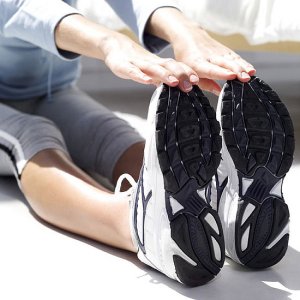Dynamic Stretching for Diabetics
The weather is finally great, and you’re running out of excuses so it’s time to exercise. Hopefully your outfit is acceptable and your favorite playlist is rockin’, so it’s time to jump in. But what first? From the days of gym class in elementary school to reading this piece, you might feel inclined to begin with some traditional, static (or still) stretching. While the traditional school of thought is that static stretching prevents injuries, in actuality static stretching before exercise has been found to be ineffective. Some studies actually find it harmful and a decrease in performance may be seen as a result from static stretching.
To avoid those tragedies, try instead coupling dynamic stretching with warm up activities like a short jog or bike ride before moving on to your scheduled workout. Dynamic stretching is a newer take on stretching that involves leg and arm swings designed to gently push the limits of your range of motion. The key is avoiding bouncing or jerky movements that contribute to actual harm of the muscles in your limbs. Another benefit of dynamic stretching is that you can address several muscles at once while you work on balance and coordination, all while warming up your body. Dynamic stretching is so effective because it causes rapid muscle activation (Minshull, 2013). Rapid muscle activation is crucial to dynamic joint stability, which is important for injury prevention throughout your workout.
How Stretching Affects Diabetes
Dynamic stretching should exist somewhere between low and medium on the spectrum of intensity. The key, again, is to prepare your body for whatever real strenuous exercise is next. In order to warm up your body for activity, you need to first perform easier exercises, but easier exercises are still exercise. This means dynamic stretching has implications on your blood sugar levels. In contrast to high intensity workouts, where adrenaline may actually raise your blood sugar, dynamic stretching is most likely caused by a dramatic drop in your levels, depending on the duration of your activity.
Stretching Examples
Alternating Arm Crosses. Start with your arms stretched out to your sides and then proceed to attempt to touch each hand to your opposite shoulder. Alternate which arm is above the other between each cross.You should feel a stretch on your shoulders, deltoids, triceps, and biceps.
Floor Touch. Walk forwards. As you take each step, pause on your heel and try and touch the ground (or your ankle) while keeping your forward leg straight. You should feel the stretch in your hamstring.
The Rockette. Continue walking forward. As you take a step this time, balance your weight on the ball of one foot and kick the other leg straight forwards, aiming for as high as possible. You should also feel this stretch in your hamstring along with your calves.
Quad + Dip: A different take on the traditional quad stretch. Rather than simply finding a wall and grabbing your ankle, instead transition from grabbing your ankle upright to simultaneously reaching for the floor with your other hand. Maintaining your balance is important in the stretch, so start slow to begin. You should feel the stretch in your quads, calves, hips and also the hamstring.
Buttocks Kick. Mimicking the pace of jogging in place, balance your weight forward on your toes. While hopping on each alternating foot on a time, kick your heels back against your rear end while moving forward. You should feel a stretch in your quads and ankles.
High Knees + Lunge + Twist. For this multi-part stretch, first grab one foot at the middle of your shin while moving your weight forward to the ball of your other foot, stretching tall. Grabbing your shin, hold your up leg against your body. Then release, and take an exaggerated step forward, Step out so that as you come down into the lunge, your forward knee bends at a perpendicular 90 degree angle. After lowering your body into the lunge, pause at the bottom raise your arms upwards, and twist your lower back against your forward knee to that your head is facing the opposite direction as the inside of your forward foot. Raise out of the lunge and repeat all steps on the other leg. You should feel this stretch on your calves, hips, quads, and lower back.
Diabetes Tips: For Quick Warm-Ups
If immediately following your dynamic stretching, you are then continuing on to the more strenuous exercises, then allow for only a small drop in blood sugar. A majority of your focus should be on tweaking your blood sugar for whatever major activity which you are participating in. The actual stretching aspect of your workout, should only take a couple of minutes, so proportionately, only small adjustments should be made.
Diabetes Tips: For Extended Warm-Ups
If you are coupling your dynamic stretching with a warm up activity like jogging or peddling on a bicycle, then prepare yourself for a more dramatic drop in blood sugar levels. If you use a pump, lower your basal rates significantly about an hour prior to the beginning of your warm up to avoid a crash. Alternatively, you can eat a snack prior to or during your warm-up to somewhat cushion the drop in blood sugar levels.
While we’re on the subject of stretching, be sure to save time for a cool-down exercise of traditional static stretching at the end of your workout for better recovery. Try it out, and watch your performance and mood increase!
For more updates and tips on how to use fitness for diabetes management and prevention. Follow me on twitter @roycHealth
Minshull C, Eston R, Bailey A, Rees D, Gleeson N. The differential effects of PNF versus passive stretch conditioning on neuromuscular performance. Eur J Sport Sci. 2014;14(3):233-41. doi: 10.1080/17461391.2013.799716. Epub 2013 May 20.

